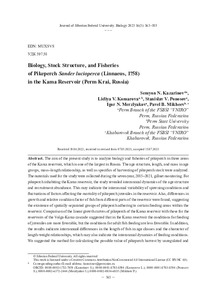Промыслово-биологическая характеристика судака Sander lucioperca (Linnaeus, 1758) Камского водохранилища (Пермский край)
Автор:
Казаринов, С. Н.
Комарова, Л. В.
Поносов, С. В.
Мерзляков, И. Н.
Михеев, П. Б.
Kazarinov, Semyon N.
Komarova, Lidiya V.
Ponosov, Stanislav V.
Merzlyakov, Igor N.
Mikheev, Pavel B.
Дата:
2023-09Журнал:
Журнал Сибирского федерального университета.Биология. Journal of Siberian Federal University.Biology, 2023 16 (3)Аннотация:
Приведены результаты исследований возрастного состава, длины и массы
в возрастных классах, зависимости массы от длины, а также особенностей эксплуатации запасов
судака в трех районах Камского водохранилища – одного из крупнейших в России. Материалом
послужили результаты семилетних наблюдений 2015–2021 гг. Выявлена межгодовая динамика
возрастного состава, а также динамика численности пополнения промыслового стада судака, что
может указывать на нестабильность условий воспроизводства и флуктуации факторов, влияющих
на смертность молоди вида. Выявлены различия в линейном росте, характере зависимости массы
от длины и коэффициенте относительной упитанности рыб из разных районов водохранилища,
свидетельствующие о сосуществовании пространственно-разобщенных
группировок судака,
придерживающихся определенных мест нагула в пределах водохранилища. Полученные результаты
межгодовых различий длины рыб в возрастных классах могут указывать на межгодовую динамику условий нагула. Сравнение кривых линейного роста судака Камского водохранилища
с таковыми для водохранилищ Волжско-Камского
каскада показало, что в Камском водохранилище
наблюдаются более благоприятные условия нагула молоди судака, но менее благоприятные
условия для нагула взрослых рыб. Полученная информация свидетельствует о пространственной
неоднородности судака, обитающего в пределах такого крупного водохранилища, как Камское,
а также о непостоянстве факторов, определяющих пополнение и условия нагула вида. Нами
предложена методика расчета возможного неучтенного изъятия рыбы на промысле, на основании
которой установлено, что объемы возможного неучтенного вылова превосходят официальные
данные в 3–5 раз. Полученные сведения важны для понимания популяционной структуры судака
в пределах крупных водных объектов, а также разработки мер по регулированию промысла вида The aim of the present study is to analyze biology and fisheries of pikeperch in three areas of the Kama reservoir, which is one of the largest in Russia. The age structure, length, and mass in age groups, mass–length relationship, as well as specifics of harvesting of pikeperch stock were analyzed. The materials used for the study were collected during the seven-year, 2015–2021, gillnet monitoring. For pikeperch inhabiting the Kama reservoir, the study revealed interannual dynamics of the age structure and recruitment abundance. This may indicate the interannual variability of spawning conditions and fluctuations of factors affecting the mortality of pikeperch juveniles in the reservoir. Also, differences in growth and relative condition factor of fish from different parts of the reservoir were found, suggesting the existence of spatially separated groups of pikeperch adhering to certain feeding areas within the reservoir. Comparison of the linear growth curves of pikeperch of the Kama reservoir with those for the reservoirs of the Volga-Kama cascade suggested that in the Kama reservoir the conditions for feeding of juveniles are more favorable, but the conditions for adult fish feeding are less favorable. In addition, the results indicate interannual differences in the length of fish in age classes and the character of length-weight relationships, which may also indicate the interannual dynamics of feeding conditions. We suggested the method for calculating the possible value of pikeperch harvest by unregulated and unreported fisheries. The approach used in the study shows that the volume of possible unaccounted
catches exceeds the official data by a factor of 3 to 5. The information obtained in the current study
suggests the existence of separate stocks of pikeperch within the Kama reservoir and the variability of
factors determining the recruitment and feeding conditions of the species. The results are important
for understanding the population structure of pikeperch within large water bodies and for managing
pikeperch fisheries

